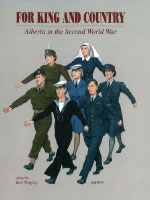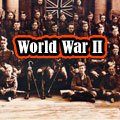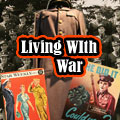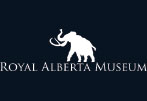Every Kitchen is an Arsenal
Catherine C. Cole
Reprinted with permission of the author and publisher of For King and Country: Alberta in the Second World War the future".7 Some refugees were welcomed with open arms; an Edmonton Journal survey found that there were hundreds of women in Alberta who were willing to take British or French refugee children.8 The idea of bringing in "guest children" from Britain came from a woman who had formerly lived in Fort Saskatchewan, but who was then living in British Columbia. Mennonites, although opposed to war on religious principle, offered to help with the refugee problem through the Red Cross. As the war progressed through Europe, Albertans with European connections initiated fundraising to assist survivors overseas and, in some cases, beginning with dispossessed Finns in the winter of 1940, efforts to bring refugees to Canada. The IODE had assisted in the acculturation of immigrants prior to the war and voiced concerns, shared by the AWI and other women's groups, about the ability of immigrants to adopt Canadian values. They passed a resolution that "anti-British aliens" should be expelled from Canada at the end of the war as the public's concern about a "Fifth Column" of enemy spies grew.9
the future".7 Some refugees were welcomed with open arms; an Edmonton Journal survey found that there were hundreds of women in Alberta who were willing to take British or French refugee children.8 The idea of bringing in "guest children" from Britain came from a woman who had formerly lived in Fort Saskatchewan, but who was then living in British Columbia. Mennonites, although opposed to war on religious principle, offered to help with the refugee problem through the Red Cross. As the war progressed through Europe, Albertans with European connections initiated fundraising to assist survivors overseas and, in some cases, beginning with dispossessed Finns in the winter of 1940, efforts to bring refugees to Canada. The IODE had assisted in the acculturation of immigrants prior to the war and voiced concerns, shared by the AWI and other women's groups, about the ability of immigrants to adopt Canadian values. They passed a resolution that "anti-British aliens" should be expelled from Canada at the end of the war as the public's concern about a "Fifth Column" of enemy spies grew.9
Voluntary Service Organizations and "Home Comforts"
In addition to the established agencies, each with their own missions in peacetime, some women formed informal groups for the duration. The Edmonton Journal periodically reported the organization of new groups with names like the "Broadview Club" and the "Homefront Guild". Gertrude Poole, wife of Ernest Poole of Poole Construction Limited, opened her home to a group of about 40 Edmonton women who knit and sewed articles for the Red Cross. [The Poole family moved to Edmonton in 1932, and has made many contributions to the community, including the donation of significant collections of paintings, some of which are shown in the photograph of the workshop, to the Edmonton Art Gallery, and decorative arts to the Provincial Museum.]
Existing women's organizations included war-related projects among their initiatives. The YWCA offered support and amusement to young girls who were facing additional responsibilities due to the war, and was instrumental in finding housing for women moving to the cities to take positions in the work force. Other organizations provided entertainment for the mothers and wives of servicemen. However, most voluntary service organizations directed their energies towards "home comforts" and fundraising,
By 1939 there were hundreds of Women's Institute branches in rural communities and urban centres throughout the province. They followed a prescribed annual programme, which included speakers on a variety of topics, instruction in various handicrafts, and fundraising for community efforts. The war once again provided an opportunity for members to serve their country as they had during the First World War, and to fulfill their motto "For Home and Country". In her 1941-1943 Report on Legislation and International Relations for the AWI, Mrs. D.W. Patterson made the following observation.
Much grief and toil will be our lot before the fighting is over. In our own small way, Alberta Women can work and pray, can bravely endure, in the dark days ahead, and can keep informed and alert in preparation for the brighter future that must emerge from the crucible of war.10
Branches focused their attention on war work, not just in terms of fundraising, producing articles for the Red Cross, and sending parcels overseas, but also within the programme itself. Often branches omitted the lectures and educational aspects of their meetings during the war, but when lectures were included they were on war-related topics such as "Causes Leading to the European War", "Post War Settlements", "Canadianization", "Women's Place in War-Time", "The Naturalization of Women", "Patriotic Work done by Women's Organizations", and "Know our Allies". These talks were either prepared by local women or were borrowed from the provincial loan collection. The handicraft aspect of the programme centred around knitting and sewing for inclusion in parcels for local soldiers or for the Red Cross.
Women in the AWI worked to make soldiers and civilian victims of the war more comfortable. They made quilts as fundraisers and for use overseas through the Canadian Women's Institute's "Blankets for Britain" campaign; made garments for refugee children; knitted socks and other garments for servicemen and servicewomen; purchased chocolates, gum and cigarettes to send overseas; wrote letters to local boys serving overseas; made "ditty bags" and purchased toiletries such as soap, toothbrushes, razor blades, hairbrushes and combs to fill them with; and made "housewives", or sewing kits, which they filled with buttons, thread, needles and yarn; and baked cookies and fruit cakes.11 The Fort Saskatchewan WI sent parcels regularly to local boys on Christmas, birthdays, and in-between, and to prisoners of war. Even though sugar and fruit were rationed, members donated their own portions for use in baking cakes. Two members made 74 Christmas cakes during the war [they were the only two with mixmasters, according to Helen Thorne, then secretary of the Home Comforts Fund]. The cakes were shared with others in their units by the local boys, and the women's efforts were very much appreciated by the soldiers. The Fort Record printed many letters of thanks, including those from Malcolm R. MacCrimmon, who wrote that:
.. {the] cake was just grand, the fellows in the band didn't give me a minutes rest until they all had a bit of it. They thoroughly enjoyed every part of it as did I. The socks are swell, in fact I think I'll save them for Sunday wear. You have no idea how much the fellows look forward to a parcel from Canada over here. It means a lot to them and its ever so good of you women to think of them.12
Fred Taylor also wrote, expressing his thanks.
Socks around here are a bone of contention and to have extra ones is to be the envy of the hut. After I showed them to the boys I had to lock them up or some one would have borrowed them before I had a chance to wear them myself.13
Notes
7. Edmonton Journal, 13 March 1940.
8. Edmonton Journal, 1 June 1940.
9. Edmonton Journal, 17 May 1940.
10. Mrs. D.W. Patterson, “A.W.I. Report on Legislation and International Relations, 1941-1943. Twenty-Third Provincial Convention.” Twenty-Third Report, A.W.I. Convention, p. 67. [PAA 74.1 RG 229 Box 9].
11. Dorothy Hosegood, nee Sissons, to Catherine Cole, 18 November 1989, quoted in Catherine C. Cole and Ann Milovic, “Education, Community Service and Social Life: The Alberta Women's Institutes and Rural Families, 1909-1945”, in Standing on New Ground: Women in Alberta, Catherine A. Cavanaugh and Randi R. Warne eds. [Edmonton, University of Alberta, 1993], p. 29.
12. Fort Record, 29 January 1941.
13. Fort Record, 24 December 1941.








